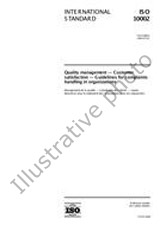We need your consent to use the individual data so that you can see information about your interests, among other things. Click "OK" to give your consent.

ISO/IEC 8473-1-ed.2.0
Information technology - Protocol for providing the connectionless-mode network service: Protocol specification - Part 1:
Translate name
STANDARD published on 22.10.1998
The information about the standard:
Designation standards: ISO/IEC 8473-1-ed.2.0
Publication date standards: 22.10.1998
SKU: NS-942856
The number of pages: 57
Approximate weight : 171 g (0.38 lbs)
Country: International technical standard
Category: Technical standards ISO
The category - similar standards:
Annotation of standard text ISO/IEC 8473-1-ed.2.0 :
This Recommendation | International Standard specifies a protocol that is used to provide the connectionless-mode Network service described in ITU-T Rec. X.213 | ISO/IEC 8348 and to perform certain Network layer management functions. The protocol relies upon the provision of an underlying connectionless-mode service by real subnetworks and/or data links. The underlying connectionless-mode service assumed by the protocol may be obtained either directly, from a connectionless-mode real subnetwork, or indirectly, through the operation of an appropriate Subnetwork Dependent Convergence Function (SNDCF) or Protocol (SNDCP) over a connection-mode real subnetwork, as described in ISO/IEC 8648. This Recommendation | International Standard specifies the operation of the protocol with respect to a uniform, abstract "underlying subnetwork service". Other Recommendations | International Standards specify the way in which this "underlying subnetwork service" is obtained from real subnetworks, such as those which conform to ISO/IEC 8802 or ISO/IEC 8208. The "underlying subnetwork service" may be obtained from real subnetworks other than those that are specifically covered by the other Recommendations | International Standards. This Recommendation | International Standard specifies: a) procedures for the connectionless transmission of data and control information from one Network entity to one or more peer Network entities; b) the encoding of the Protocol Data Units (PDUs) used for the transmission of data and control information, comprising a variable-length protocol header format; c) procedures for the correct interpretation of protocol control information; and d) the functional requirements for implementations claiming conformance to this Recommendation | International Standard. The procedures are defined in terms of: a) the interactions among peer Network entities through the exchange of protocol data units; b) the interactions between a Network entity and a Network service user through the exchange of Network service primitives; and c) the interactions between a Network entity and an abstract underlying service provider through the exchange of service primitives. This Recommendation | International Standard also provides the PICS proforma for this protocol, in compliance with the relevant requirements, and in accordance with the relevant guidance, given in ITU-T Rec. X.290 | ISO/IEC 9646-1 La presente Recommandation 1 Norme internationale specifie un protocole servant a assurer le Service de reseau en mode sans connexion dkr-it dans la Rec. UIT-T X.213 1 ISOKEI 8348 et a executer certaines fonctions de gestion dans la couche Reseau. Dans lapplication de ce protocole, on suppose que des sous-reseaux reels ou des liaisons de donnees assurent un Service de base en mode sans connexion. Ce Service de base en mode sans connexion, assure par hypothese, peut etre obtenu soit directement a partir dun sous-reseau reel en mode sans connexion, soit indirectement par lintermediaire dune fonction ou dun protocole de convergence approprie dependant du sous-reseau (respectivement SNDCF et SNDCP) selon la description donnee dans lISO/CEI 8648. La presente Recommandation 1 Norme internationale specifie le deroulement du protocole par reference a un "Service de sous-reseau de base" abstrait et uniforme. Dautres Recommandations 1 Norme internationale specifient les modalites dobtention de ce "Service de sous-reseau de base" a partir de sous-reseaux reels, par exemple a partir de sous-reseaux conformes a IISOKEI 8802 ou a lISO/CEI 8208. Le "Service de sous-reseau de base" peut etre obtenu a partir de sous-reseaux reels autres que les sous-reseaux specifiquement couverts par les autres Recommandations ( Normes internationales. La presente Recommandation 1 Norme internationale specifie : a) les procedures de transmission en mode sans connexion de donnees et une entite de reseau et une ou plusieurs entites de reseau homologues ; dinformations de commande entre b) le codage des unites de donnees de protocole (PDU, Protocol data mit) utilise pour Ia transmission des donnees et des informations de commande, notamment un format den-tete de protocole de longueur variable ; c) les procedures dinterpretation correcte des informations de commande du protocole ; d) les caracteristiques fonctionnelles des applications declarees con formes Norme internationale. Les procedures sont definies par reference : a) aux interactions entre entites de reseau homologues resultant de lechange dunites de donnees de protocole. b) aux interactions entre une entite de reseau et un utilisateur de Service de reseau, resultant de lechange des primitives de Service de reseau; c) aux interactions entre une entite de reseau et un fouisseur de Service de base abstrait, resultant de lechange de primitives de Service. La presente Recommandation ( Norme internationale comprend egalement un formulaire PICS conforme aux conditions pertinentes et aux directives applicables, exposees dans la UIT-T Rec. X.290 1 ISO/CEI 9646-1.
We recommend:
Technical standards updating
Do you want to make sure you use only the valid technical standards?
We can offer you a solution which will provide you a monthly overview concerning the updating of standards which you use.
Would you like to know more? Look at this page.



 Cookies
Cookies
